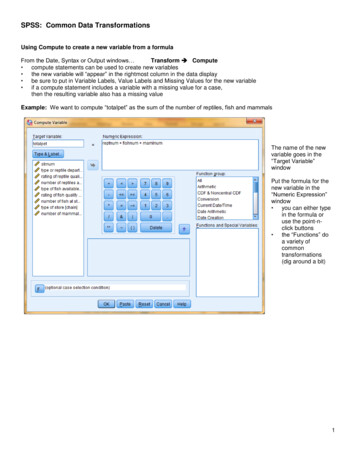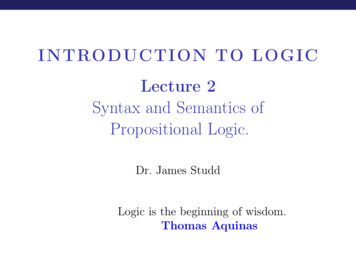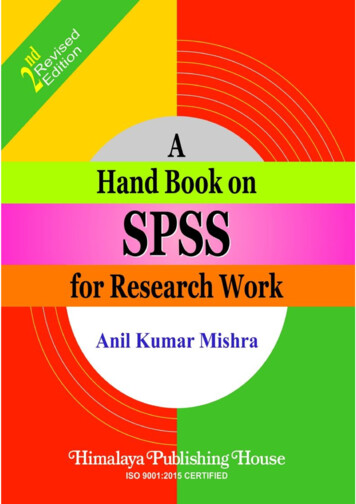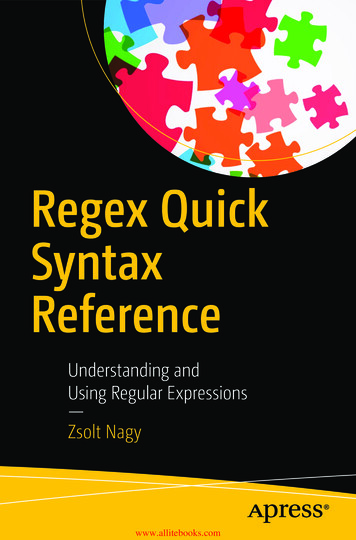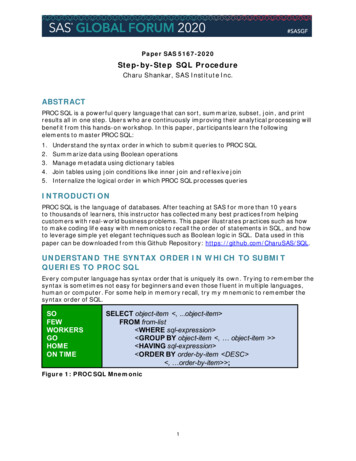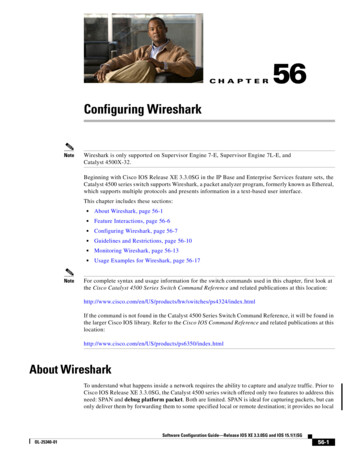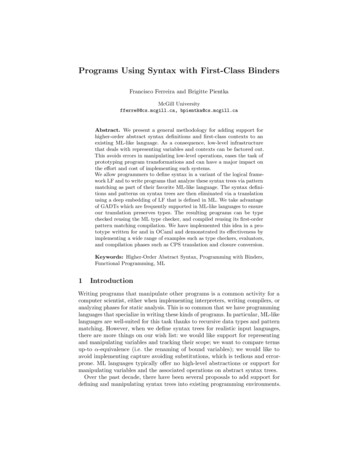
Transcription
Programs Using Syntax with First-Class BindersFrancisco Ferreira and Brigitte PientkaMcGill Universityfferre8@cs.mcgill.ca, bpientka@cs.mcgill.caAbstract. We present a general methodology for adding support forhigher-order abstract syntax definitions and first-class contexts to anexisting ML-like language. As a consequence, low-level infrastructurethat deals with representing variables and contexts can be factored out.This avoids errors in manipulating low-level operations, eases the task ofprototyping program transformations and can have a major impact onthe effort and cost of implementing such systems.We allow programmers to define syntax in a variant of the logical framework LF and to write programs that analyze these syntax trees via patternmatching as part of their favorite ML-like language. The syntax definitions and patterns on syntax trees are then eliminated via a translationusing a deep embedding of LF that is defined in ML. We take advantageof GADTs which are frequently supported in ML-like languages to ensureour translation preserves types. The resulting programs can be typechecked reusing the ML type checker, and compiled reusing its first-orderpattern matching compilation. We have implemented this idea in a prototype written for and in OCaml and demonstrated its effectiveness byimplementing a wide range of examples such as type checkers, evaluators,and compilation phases such as CPS translation and closure conversion.Keywords: Higher-Order Abstract Syntax, Programming with Binders,Functional Programming, ML1IntroductionWriting programs that manipulate other programs is a common activity for acomputer scientist, either when implementing interpreters, writing compilers, oranalyzing phases for static analysis. This is so common that we have programminglanguages that specialize in writing these kinds of programs. In particular, ML-likelanguages are well-suited for this task thanks to recursive data types and patternmatching. However, when we define syntax trees for realistic input languages,there are more things on our wish list: we would like support for representingand manipulating variables and tracking their scope; we want to compare termsup-to α-equivalence (i.e. the renaming of bound variables); we would like toavoid implementing capture avoiding substitutions, which is tedious and errorprone. ML languages typically offer no high-level abstractions or support formanipulating variables and the associated operations on abstract syntax trees.Over the past decade, there have been several proposals to add support fordefining and manipulating syntax trees into existing programming environments.
For example: FreshML [22], the related system Romeo [23], and Cαml [20] useNominal Logic [18] as a basis and the Hobbits library for Haskell [25] usesa name based formalism. In this paper, we show how to extend an existing(functional) programming language to define abstract syntax trees with variablebinders based on higher-order abstract syntax (HOAS) (sometimes also calledλ-trees [11]). Specifically, we allow programmers to define object languages in thesimply-typed λ-calculus where programmers use the intentional function spaceof the simply typed λ-calculus to define binders (as opposed to the extensionalfunction space of ML). Hence, HOAS representations inherit α-renaming fromthe simply-typed λ-calculus and we can model object-level substitution for HOAStrees using β-reduction in the underlying simply-typed λ-calculus. We furtherallow programmers to express whether a given sub-tree in the HOAS tree isclosed by using the necessity modality of S4 [6]. This additional expressiveness isconvenient to describe that sub-trees in our abstract syntax tree are closed.Our work follows the pioneering work of HOAS representations in the logicalframework LF [9]. On the one hand we restrict it to the simply-typed settingto integrate it smoothly into existing simply-typed functional programminglanguages such as OCaml, and on the other hand we extend its expressivenessby allowing programmers to distinguish between closed and open parts of theirsyntax trees. As we analyze HOAS trees, we go under binders and our sub-treesmay not remain closed. To model the scope of binders in sub-trees we pair aHOAS tree together with its surrounding context of variables following ideasfrom Beluga [15,12]. In addition, we allow programmers to pattern match onsuch contextual objects, i.e. an HOAS tree together with its surrounding context.Our contribution is two-fold: First, we present a general methodology foradding support for HOAS tree definitions and first-class contexts to an existing(simply-typed) programming language. In particular, programmers can definesimply-typed HOAS definitions in the syntactic framework (SF) based on modalS4 following [12,6]. In addition, programmers can manipulate and pattern matchon well-scoped HOAS trees by embedding HOAS objects together with theirsurrounding context into the programming language using contextual types [15].The result is a programming language that can express computations over openHOAS objects. We describe our technique abstractly and generically using alanguage that we call Core-ML. In particular, we show how Core-ML with firstclass support for HOAS definitions and contexts can be translated in into alanguage Core-MLgadt that supports Generalized Abstract Data Types (GADTs)using a deep (first-order) embedding of SF and first-class contexts (see Fig. 1 foran overview). We further show that our translation preserves types.Second, we show how this methodology can be realized in OCaml by describingour prototype Babybel1 . In our implementation of Babybel we take advantage ofthe sophisticated type system, in particular GADTs, that OCaml provides toensure our translation is type-preserving. By translating HOAS objects togetherwith their context to a first-order representation in OCaml with GADTs wecan also reuse OCaml’s first-order pattern matching compilation allowing for1available at www.github.com/fferreira/babybel/
Core-ML ContextualTypesCore-MLgadtSyntacticFrameworkFig. 1. Adding Contextual Types to MLa straightforward compilation. Programmers can also exploit OCaml’s impurefeatures such as exceptions or references when implementing programs thatmanipulate HOAS syntax trees. We have used Babybel to implement a typechecker, an evaluator, closure conversion (shown in Section 2.3 together with avariable counting example and a syntax desugaring examples), and a continuationpassing style translation. These examples demonstrate that our approach allowsprogrammers to write programs that operate over abstract syntax trees in amanner that is safe and effective.Finally, we would like to stress that our translation which eliminates thelanguage extensions and permits programmers to define, analyze and manipulateHOAS trees is not specific to OCaml or even to simple types in our implementation.The same approach could be implemented in Haskell, and with some care (to bereally useful it would need an equational theory for substitutions) this techniquecan be extended to a dependently typed language.2Main IdeasIn this section, we show some examples that illustrate the use of Babybel, ourproof of concept implementation where we embed the syntactic framework SFinside OCaml. To smoothly integrate SF into OCaml, Babybel defines a PPXfilter (a mechanism for small syntax extensions for OCaml). In particular, weuse attributes and quoted strings to implement our syntax extension.2.1Example: Removing Syntactic SugarIn this example, we describe the compact and elegant implementation of acompiler phase that de-sugars programs functional programs with let-expressionsby translating them into function applications. We first specify the syntax ofa simple functional language that we will transform. To do this we embed thesyntax specification using this tag:[@@@signature {def . def}]Inside the @@@signature block we will embed our SF specifications.
Our source language is defined using the type tm. It consists of constants(written as cst), pairs (written as pair), functions (built using lam), applications(built using app), and let-expressions.[@@@signature {def tm : type.cst: tm.pair: tm tm tm.lam: (tm tm) tm.fst: tm tm.snd: tm tm.letpair : tm (tm tm tm) tm.letv: tm (tm tm) tm.app: tm tm tm. def}]Our definition of the source language exploits HOAS using the function spaceof our syntactic framework SF to represent binders in our object language. Forexample, the constructor lam takes as an argument a term of type tm tm.Similarly, the definition of let-expressions models variable binding by fallingback to the function space of our meta-language, in our case the syntacticframework SF. As a consequence, there is no constructor for variables in oursyntactic definition and moreover we can reuse the substitution operation fromthe syntactic framework SF to model substitution in our object language. Thisavoids building up our own infrastructure for variables bindings.We now show how to simplify programs written in our source language byreplacing uses of letpair in terms with projections, and uses of letv by β reduction. Note how we use higher-order abstract syntax to represent let-expressionsand abstractions.letv M (λx.N ) N[M /x]letpair M (λx.λy. N ) N[(fst M )/x,(snd M )/y]To implement this simplification phase we implement an OCaml programrewrite: it analyzes the structure of our terms, calls itself on the sub-terms, andeliminates the use of the let-expressions into simpler constructs. As we traverseterms, our sub-terms may not remain closed. For simplicity, we use the samelanguage as source and target for our transformation. We therefore specify thetype of the function rewrite using contextual types pairing the type tm togetherwith a context γ in which the term is meaningful inside the tag [@type . ].rewrite[@type γ.[γ tm] [γ tm]]The type can be read: for all contexts γ, given a tm object in the context γ,we return a tm object in the same context. In general, contextual types associatea context and a type in the syntactic framework SF. For example if we wantto specify a term in the empty context we would write [ tm] or for a termthat depends on some context with at least one variable and potentially more wewould write [γ,x:tm tm].
We now implement the function rewrite by pattern matching on the structureof a contextual term. In Babybel, contextual terms are written inside boxes(L.M) and contextual patterns inside (L.Mp ).let rec rewrite[@type γ.[γ tm] [γ tm]] function L cst Mp LcstM L pair ’m ’n Mp let mm, nn rewrite m, rewrite nin Lpair ’mm ’nnM L fst ’m Mp let mm rewrite m in Lfst ’mmM L snd ’m Mp let mm rewrite m in Lsnd ’mmM L app ’m ’n Mp let mm,nn rewrite m, rewrite n inLapp ’mm ’nnM L lam (λx. ’m) Mp let mm rewrite m in Llam (λx. ’mm)M L #x Mp L#xM L letpair ’m (λf.λs. ’n) Mp let mm rewrite m inrewrite L’n [snd ’mm;fst ’mm]M L letv ’m (λx. ’n) Mp rewrite L’n[’m]MNote that we are pattern matching on potentially open terms. Although we donot write the context γ explicitly, in general patterns may mention their context(i.e.: L cstMp 2 . As a guiding principle, we may omit writing contexts, if theydo not mention variables explicitly and are irrelevant at run-time. Inside patternsor terms, we specify incomplete terms using quoted variables (e.g.: ’m). Quotedvariables are an ’unboxing’ of a computational expression inside the syntacticframework SF. The quote signals that we are mentioning the computationalvariable inside SF.The interesting cases are the let-expressions. For them, we perform the rewritingaccording to the two rules given earlier. The syntax of the substitutions puts insquare brackets the terms that will be substituted for the variables. We considercontexts and substitutions ordered, this allows for efficient implementations andmore lightweight syntax (e.g.: substitutions omit the name of the variables becausecontexts are ordered). Importantly, the substitution is an operation that is eagerlyapplied during run-time and not part of the representation. Consequently, therepresentation of the terms remains normal and substitutions cannot be writtenin patterns. We come back to this design decision later.To translate contextual SF objects and contexts, Babybel takes advantageof OCaml’s advanced type system. In particular, we use Generalized AbstractData Types [4,26] to index types with the contexts in which they are valid. Typeindices, in particular contexts, are then erased at run-time.2.2Finding the Path to a VariableIn this example, we compute the path to a specific variable in an abstract syntaxtree describing a lambda-term. This will show how to specify particular context2The underscore means that there might be a context but we do not bind any variablefor it because contexts are not available at run-time.
shapes, how to pattern match on variables, how to manage our contexts, andhow the Babybel extensions interact seamlessly with OCaml’s impure features.For this example, we concentrate on the fragment of terms that consists only ofabstractions and application which we repeat here.[@@@signature {def tm : type.app : tm tm tm.lam : (tm tm) tm. def}]To find the first occurrence of a particular variable in the HOAS tree, weuse backtracking that we implement using the user-defined OCaml exceptionNot found. To model the path to a particular variable occurrence in the HOAStree, we define an OCaml data type step that describes the individual steps wetake and finally model a path as a list of individual steps.exception Not foundtype step Here (*the path ends here*) AppL (*take left on app*) AppR (*take right on app*) InLam (*go inside the body of the term*)type path step listThe main function path aux takes as input a term that lives in a contextwith at least one variable and returns a path to the occurrence of the top-mostvariable or an empty list, if the variable is not used. Its type is:[@type γ. [γ, x:tm tm] path].We again quantify over all contexts γ and require that the input term is meaningfulin a context with at least one variable. This specification simply excludes closedterms since there would be no top-most variable. Note also how we mix in thetype annotation to this function both contextual types and OCaml data types.let rec path aux [@type γ.[γ, x:tm tm] path] function L , x xMp [Here] L , x #yMp raise Not found L , x lam (λy. ’m)Mp InLam::(path auxL ,x,y ’m[ ;y;x]M) L , x app ’m ’nMp try AppL::(path aux m)with AppR::(path aux n)All patterns in this example make the context explicit, as we pattern match onthe context to identify whether the variable we encounter refers to the top-mostvariable declaration in the context. The underscore simply indicates that theremight be more variables in the context. The first case, matches against the boundvariable x. The second case has a special pattern with the sharp symbol, thepattern #y matches against any variable in the context , x. Because of the first
pattern if it had been x it would have matched the first case. Therefore, it simplyraises the exception to backtrack to the last choice we had.The case for lambda expressions is interesting because the recursive call happensin an extended context. Furthermore, in order to keep the variable we are searchingfor on top, we need to swap the two top-most variables. For that purpose, weapply the [ ; y; x] substitution. In this substitution the underscore standsfor the identity on the rest of the context, or more precisely, the appropriate shiftin our internal representation that relies on de Bruijn encoding. Once elaborated,this substitution becomes [ 2 ; y; x] where the shift by two arises, becausewe are swapping variables as opposed to instantiating them.The final case is for applications. We first look on the left side and if that raisesan exception we catch it and search again on the right. We again use quotedvariables (e.g.: ’m) to bind and refer to ML variables in patterns and terms of thesyntactic framework and more generally be able to describe incomplete terms.let get path [@type γ.[γ, x:tm tm] path] fun t try path aux t with []The get path function has the same type as the path aux function. It simplyhandles the exception and returns an empty path in case that variable x is notfound in the term.2.3Closure ConversionIn the final example, we describe the implementation of a naive algorithm forclosure conversion for untyped λ-terms following [3]. We take advantage of thesyntactic framework SF to represent source terms (using the type family tm)and closure-converted terms (using the type family ctm). In particular, we useSF’s closed modality box to ensure that all functions in the target language areclosed. This is impossible when we simply use LF as the specification frameworkfor syntax as in [3]. We omit here the definition of lambda-terms, our sourcelanguage, that was given in the previous section and concentrate on the targetlanguage ctm.[@@@signature {def ctm: type. % closed termbtm: type. % binder termsub: type. % environmentcappclamcloembedbind:::::ctm ctm ctm.{btm} ctm.ctm sub ctm.ctm btm.(ctm btm) btm.empty : sub.dot: sub ctm sub. def}]
Applications in the target language are defined using the constructor cappand simply take two target terms to form an application. Functions (constructorclam), however, take a btm object wrapped in {} braces. This means that theobject inside the braces is closed. The curly braces denote the internal closedmodality of the syntactic framework. As the original functions may depend onvariables in the environment, we need closures where we pair a function witha substitution that points to the appropriate environment. We define our ownsubstitutions explicitly, because they are part of the target language and thebuilt-in substitution is an operation on terms that is eagerly computed away.Inside the body of the function, we need to bind all the variables from theenvironment that the body uses such that later we can instantiate them applyingthe substitution. This is achieved by defining multiple bindings using constructorsbind and embed inside the term.When writing a function that translates between representations, their openterms depend on contexts that store assumptions of different representations andit is often the case that one needs to relate these contexts. In our example herewe define a context relation that keeps the input and output contexts in syncusing a GADT data type rel in OCaml where we model contexts as types. Therelation statically checks correspondence between contexts, but it is also availableat run-time (i.e. after type-erasure).type ( , ) rel Empty : ([.], [.]) rel Both : ([γ], [δ]) rel ([γ, x:tm], [δ, y:ctm]) relexception Error of stringlet rec lookup [@type γ δ.[γ tm] (γ, δ) rel [δ ctm]] fun t function Both r’ begin match t with L ,x x Mp L ,x xM L ,x ##v Mp let v1 lookup L#vM r’in L , x ’v1 [ ]M raise Error (‘‘Term that is not a variable’’) Empty raise Error (‘‘Term is not a variable’’)endThe function lookup searches for related variables in the context relation. Ifwe have a source context γ,x:tm and a target context δ,y:ctm, then we considertwo variable cases: In the first case, we use matching to check that we are indeedlooking for the top-most variable x and we simply return the corresponding targetvariable. If we encounter a variable from the context, written as ##v, then werecurse in the smaller context stripping off the variable declaration x. Note that##v denotes a variable from the context , that is not x, while #v describes avariable from the context , x, i.e. it could be also x. The recursive call returnsthe corresponding variable v1 in the target context that does not include thevariable declaration x. We hence need to weaken v1 to ensure it is meaningful in
the original context. We therefore associate ’v1 with the identity substitutionfor the appropriate context, namely: [ ]. In this case, it will be elaborated intoa one variable shift in the internal de Bruijn representation that is used in ourimplementation. The last case returns an exception whenever we are trying tolook up in the context something that is not a variable.As we cannot express at the moment in the type annotation that the inputto the lookup function is indeed only a variable from the context γ and not anarbitrary term, we added another fall-through case for when the context is empty.In this case the input term cannot be a variable, as it would be out of scope.Finally, we implement the function conv which takes an untyped source term ina context γ and a relation of source and target variables, described by (γ, δ) reland returns the corresponding target term in the target context δ.let rec close [@type γ δ. (γ, δ) rel [δ btm] [btm]] fun r m match r with Empty m Both r close r Lbind (λx. ’m)Mlet rec envr [@type γ δ. (γ, δ)rel [δ sub]] fun r match r with Empty LemptyM Both r let s envr r in L , x dot (’s[ ]) xMlet rec conv [@type γ δ.(γ, δ)rel [γ tm] [δ ctm]] fun r m match m with L lam (λx. ’m) Mp let mc conv (Both r) m inlet mb close r Lbind(λx. embed ’mc)Min let s envr r in Lclo (clam {’mb}) ’sM L#xMp lookup L#xM r Lapp ’m ’nMp let mm, nn conv r m, conv r n inLcapp ’mm ’nnMThe core of the translation is defined in functions conv, envr, and close. Themain function is conv. It is implemented by recursion on the source term. Thereare three cases: i) source variables simply get translated by looking them up in thecontext relation, ii) applications just get recursively translated each term in theapplication, and iii) lambda expressions are translated recursively by convertingthe body of the expression in the extended context (notice the recursive call withBoth r) and then turning the lambda expression into a closure.In the first step we generate the closed body by the function close that addsthe multiple binders (constructors bind and embed) and generates the closedterm. Note that the return type [btm] of close guarantees that the final resultis indeed a closed term, because we omit the context. For clarity, we could havewritten [ btm].
Finally, the function envr computes the substitution (represented by the typesub) for the closure.The implementation of closure conversion shows how to enforce closed termsin the specification, and how to make contexts and their relationships explicit atrun-time using OCaml’s GADTs. We believe it also illustrates well how HOAStrees can be smoothly manipulated and integrated into OCaml programs thatmay use effects.3Core-ML: A Functional Language with PatternMatching and Data TypesWe now introduce Core-ML, a functional language based on ML with patternmatching and data types. In Section 5 we will extend this language to alsosupport contextual types and terms in our syntactic framework SF.We keep the language design of Core-ML minimal in the interest of clarity.However, our prototype implementation which we describe in Section 9 supportsinteraction with all of OCaml’s features such as exceptions, references andGADTs.TypesExpressionsNeutral Exp.PatternsBranchesContextsSignatureτ :: D τ1 τ2 e :: i fun f (x) e let x i in e match i with b i :: i e C e x e:τ pat :: C pat xb :: pat 7 eΓ :: · Γ, x : τ Ξ :: · Ξ, D Ξ, C : τ DIn Core-ML, we declare data-types by adding type formers (D) and typeconstructors (C) to the signature (Ξ). Constructors must be fully-applied. Inaddition all functions are named and recursive. The language supports patternmatching with nested patterns where patterns consist of just variables and fullyapplied constructors. We assume that all patterns are linear (i.e. each variableoccurs at most once) and that they are covering.The bi-directional typing rules for Core-ML have access to a signature Ξ andare standard (see Fig. 2). For lack of space, we omit the operational semanticswhich is standard. We also will not address the details of pattern matchingcompilation but merely state that it is possible to implement it in an efficientmanner using decision trees [1].4A Syntactic FrameworkIn this section we describe the Syntactic Framework (SF) based on S4 [6]. Ourframework characterizes only normal forms. All computation is delegated to theML layer, that will perform pattern matching and substitutions on terms.
Γ e τ : Expression e checks against type τ in context ΓΓ, f : τ τ 0 , x : τ e τ 0Γ i τ 0 Γ, x : τ 0 e τt-let0 t-recΓ fun f (x) e τ τΓ let x i in e τ Γ i τ 0 bk b . Γ bk τ 0 τ00t-match Γ i τ τ τ t-emb Γ match i with b τΓ i τΓ i τ : Neutral expr. i synthesizes type τ in context Γ Ξ(C) τ D τi τ . ei e . Γ e i τiΓ e τt-constrt-ann Γ e:τ τΓ C e DΓ i τ 0 τ Γ e τ 0 t-appΓ ie τΓ (x) τt-varΓ x τΓ pat 7 e τ1 τ2 : Branch pat 7 e checks against types τ1 and τ2 in Γ pat : τ 0 Γ 0 Γ, Γ 0 e τt-branchΓ pat 7 e τ 0 τ pat : τ Γ : Pattern pat is of type τ and binds variables in context Γt-pat-var x:τ x:τ Ξ(C) τ D τi τ . pati pat . pati : τi Γit-pat-con C pat : D Γ1 , ., ΓiFig. 2. Core-ML Typing Rules4.1The definition of SFThe Syntactic Framework (SF) is a simply typed λ-calculus based on S4 wherethe type system forces all variables to be of base type, and all constants declaredin a signature Σ to be fully applied. This simplifies substitution, as variables ofbase type cannot be applied to other terms, and in consequence, there is no needfor hereditary substitution in the specification language. Finally, the syntacticframework supports the box type to describe closed terms [13]. It can also beviewed as a restricted version of the contextual modality in [12] which could bean interesting extension to our work.Having closed objects enforced at the specification level is not strictly necessary.However, being able to state that some objects are closed in the specificationhas two distinct advantages: first, the user can specify some objects as closed sotheir contexts are always empty. This removes the need for some unnecessarysubstitutions. Second, it allows us to encode more fine-grained invariants and ishence an important specification tool (i.e. when implementing closure conversion
in Section 2.3).TypesA, B :: a A B A TermsM, N :: c M λx.M {M } xContexts Ψ, Φ :: · Ψ, x : aSignatureΣ :: · Σ, a : K Σ, c : AFig. 3 shows the typing rules for the syntactic framework. Note that constructorsalways are fully applied (as per rule t-con), and that all variables are of basetype as enforced by rules t-var and t-lam.Ψ M : A : M has type A in context ΨΨ, x : a M : At-lamΨ λx.M : a AΨ (x) a· M :At-boxt-varΨ {M } : AΨ x:a Σ(c) A Ψ M : A/at-con Ψ cM : a Ψ M : A/a : spine M checks against type A and has target type a Ψ N : A Ψ M : B/at-spt-sp-em Ψ · : a/aΨ N, M : A B/aFig. 3. Syntactic Framework Typing4.2Contextual TypesWe use contextual types to embed possibly open SF objects in Core-ML andensure that they are well-scoped. Contextual types pair the type A of an SFobject together with its surrounding context Ψ in which it makes sense. Thisfollows the design of Beluga [15,3].Contextual TypesU :: [Ψ A]Type Erased Contexts Ψ̂ :: · Ψ̂ , xContextual ObjectsC :: [Ψ̂ M ]Contextual objects, written as [Ψ̂ M ] pair the term M with the variablename context Ψ̂ to allow for α-renaming of variables occurring in M . Note howthe Ψ̂ context just corresponds to the context with the typing assumptions erased.When we embed contextual objects in a programming language we want torefer to variables and expressions from the ambient language, in order to supportincomplete terms. Following [12,15], we extend our syntactic framework SF with
two ideas: first, we have incomplete terms with meta-variables to describe holes interms. As in Beluga, there are two different kinds: quoted variables ’u representa hole in the term that may be filled by an arbitrary term. In contrast, parametervariables v represent a hole in a term that may be filled only with some boundvariable from the context. Concretely, a parameter variable may be #x anddescribe any concrete variable from a context Ψ . We may also want to restrictwhat bound variables a parameter variable describes. For example, if we have twosharp signs (i.e. ##x) the top-most variable declaration is excluded. Intuitively,the number of sharp signs, after the first, in front of x correspond to a weakening(or in de Bruijn lingo the number of shifts). Second, substitution operations allowus to move terms from one context to another.We hence extend the syntactic framework SF with quoted variables, parametervariables and closures, written as M [σ]ΦΨ . We annotate the substitution with itsdomain and range to simplify the typing rule, however our prototype omits thesetyping annotations and lets type inference infer them.Parameter Variables v :: #x #vTermsM :: · · · ’u v M [σ]ΦΨSubstitutionsσ :: · σ, M/xAmbient Ctx.Γ :: · · · Γ, u : [Ψ a]In addition, we extend the context Γ of the ambient language Core-ML tokeep track of assumptions that have a contextual type.Finally, we extend the typing rules of the syntactic framework SF to includequoted variables, parameter variables, closures, and substitutions. We keep allthe previous typing rules for SF from Section 4 where we thread through theambient Γ , but the rules remain unchanged otherwise.Γ ; Ψ v v : a : Parameter Variable v has type a in contexts Ψ and ΓΓ (x) [Ψ a]Γ ; Ψ v v : at-pvar-vt-pvar-#Γ ; Ψ v #x : aΓ ; Ψ, y : v #v : aΓ ; Ψ M : A : Term M has type A in contexts Ψ and ΓΓ (u) [Ψ a]Γ ; Ψ v v : at-qvart
inside OCaml. To smoothly integrate SF into OCaml, Babybel de nes a PPX lter (a mechanism for small syntax extensions for OCaml). In particular, we use attributes and quoted strings to implement our syntax extension. 2.1 Example: Removing Syntactic Sugar In this example, we describe the compact and elegant implementation of a

